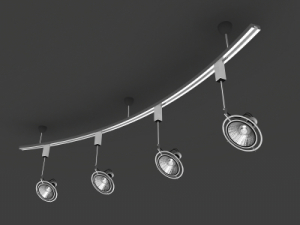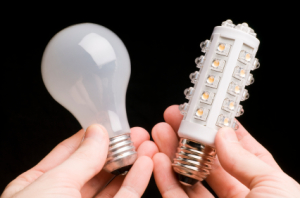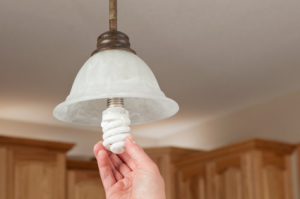Home Lighting
Shopping for lightbulbs these days can feel like a dive into alphabet soup. As incandescents take a backseat to more efficient technologies like CFLs and LEDs, we asked lighting expert Jeff Waymouth to give us the scoop.
Q. Why is it so hard for consumers to find a good, old-fashioned lightbulb nowadays? 
A. Our federal government has passed legislation that requires manufacturers to make lightbulbs more efficient than the “good, old-fashioned” incandescent lightbulbs were. These requirements are being gradually phased in. Most American houses still contain lamps and fixtures designed for incandescent sources, whether omnidirectional, like the common table lamp, or directional sources, often called reflector lamps. Replacement technologies include tungsten halogen, compact fluorescent, and LED (Light-Emitting Diode) products all designed to fit and operate in the same lamps and fixtures as the bulbs they were designed to replace.
Q. Can you break down the differences between CFLs and LEDs?
A. “CFL” stands for Compact Fluorescent Lamp. As its name suggests, it works the same way the long fluorescent tubes do, it is just made smaller by using a narrower diameter tubing and many bends or twists. CFLs designed to replace incandescent lightbulbs do not require extra gear because they are self-ballasted. They can be as much as four times as efficient as an incandescent, so a 23-watt CFL can suitably replace a 100-watt old-style incandescent. CFLs also last much longer, often 8,000 to 10,000 hours as compared to the 750- to 2,500-hour life of the “old-style” incandescent. When CFLs are switched on, they need a little time to warm up to full brightness. They can also be sensitive to surrounding temperature, sometimes operating more dimly in cold temperatures.
“LED” stands for Light-Emitting Diode, often referred to as “solid state” lighting. Products using this technology frequently use many separate “chips” in order to produce even light patterns similar to the incandescent. Like CFLs, LEDs designed to replace incandescent products are self-ballasted and do not require extra gear to operate in those fixtures or lamps. A 20-watt LED can suitably replace a 100-watt incandescent. An LED product is generally a little more efficient than a CFL product designed for the same purpose and will save a little more energy. Unlike CFLs, LEDs do not need any warm-up time and are not sensitive to cold weather. LED products can have exceptionally long lives—some are rated at 25,000 hours or longer.
Q. What applications in the home would CFLs be best suited? What about LEDs?
A. There are LED and CFL products suitable for most household applications except, perhaps, the light in your oven. However, unless the LED or CFL is specifically rated to use with dimmers or electronic switches (like photocells or electronic timers) they should not be used with such devices and may perform poorly, or not all, if they are.
Q. What options exist on the market today for CFLs? LEDs? And what considerations should consumers take into account when shopping for each?
A. For the retail customer, considering use in the household, CFL products are generally designed to replace incandescent products. LEDs have been designed for that purpose as well, but new applications for that technology are constantly being developed. We now see “stick-on” battery-operated LED lights for areas like closets, which are hard to light. There are LED booklights, nightlights, flashlights, and worklights designed to be worn around one’s head. There are many other options for LED sources and new ones are regularly being developed.
Q. CFLs and LEDs are sold in different color temperatures. What does this mean and what should consumers be looking for?
A. Color temperature is used to describe the appearance of the light itself and has nothing to do with the physical temperature of the bulb itself. Both CFL and LED products will be cooler to the touch than incandescent. Lower color temperatures, like 2700K or 3000K, appear “warmer” (redder) than higher color temperatures like 4100K or 5000K, which appear “cooler” (bluer). LED products are better at representing colors more truly. CFLs can cause a little more “color shift” than LEDs, and in that regard the “old-fashioned” incandescent lightbulb was still better. If you are planning on using a dimmer or electronic switching device, such as a photocell or electronic timer, be sure to select an LED or CFL product specifically marked for use with those products. It should be noted that both the CFL and the LED products are likely to be heavier than the incandescent product they were designed to replace due to material required for their construction and operation.
Q. What other technologies exist in the marketplace to replace incandescents? 
A. There is a third optional technology available to replace standard incandescent. Tungsten halogen, sometimes called “halogen” or incandescent halogen,” replacement products are still available. While they have shorter lives than CFLs or LEDs (generally around 2,000 hours) and are less efficient, they still save energy over incandescents, and they have no problems whatsoever with dimming or electronic switching of any type.
Jeff Waymouth has been with OSRAM SYLVANIA since 1978. His career began as a manufacturing engineer in their HID facility for 8 years before moving into a technical support role as a district engineer, regional engineer, and commercial engineer supporting customers, sales force, and marketing groups for 15 years. Jeff then became the senior applications engineer for OSRAM SYLVANIA’s fluorescent business unit, providing in-depth support to the entire lighting industry for 8 years before he moved into the field of standards in 2008. Jeff brings a thorough understanding of lighting systems, manufacturing processes, and the practicalities of the lighting business. He is active in IESNA and is “Lighting Certified” (LC) by the NCQLP.